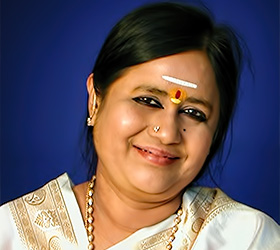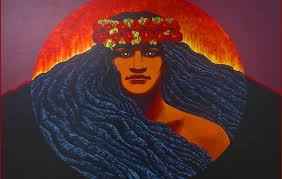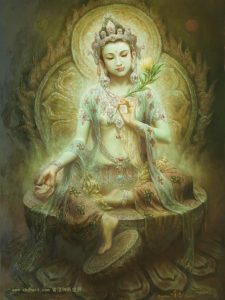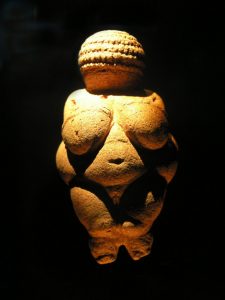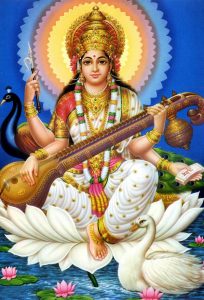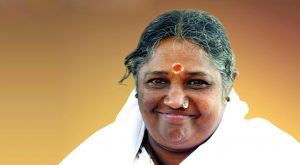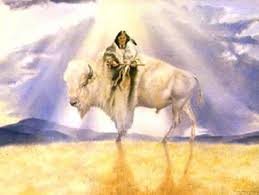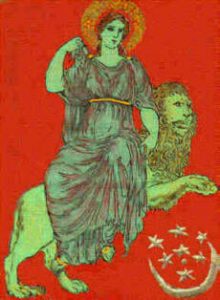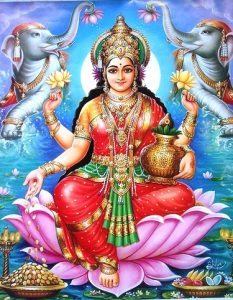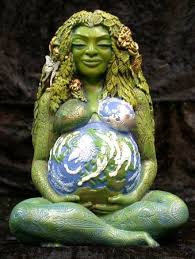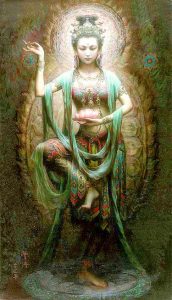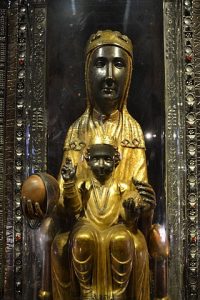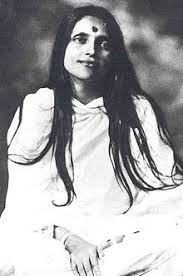Amma was born in 1958 in southern India and is a Hindu spiritual leader who still travels all over the world promoting peace and meditation. She spent her childhood on spiritual paths and in prayer and worship, and her mother was a devotee of Ramana Maharshi. She is considered to be an avatar who was born enlightened. She is called Amma by her devotees, which means “mother” in her native Telugu language (the language spoken by Sai Baba). She’ has created several charitable programs to help the extremely poor people where her ashram is located. These provide free educational facilities, housing projects, clean water programs, a free hospital, mobile medical clinics, emergency relief programs, food and clothing donations.
Pele is the Hawaiian goddess of fire and volcanoes. She has the power to create and destroy: she devours the Big Island with molten lava, but this also creates new land in the process. Because of her power to create, she may be thought to have maternal traits. Hawaiians say that she resides in one of the most active volcanoes in the world — at the summit of Kīlauea, on the Big Island. Many say Pele’s face has mysteriously appeared in their photos of the lava lake within the crater or in molten lava flows.
Artemis (Greek), or Diana (Roman)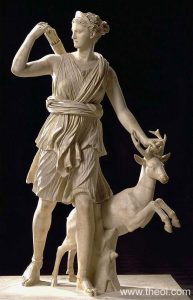
Artemis, the goddess of forests and hills, was worshipped throughout ancient Greece. She is the patron goddess of hunters, wilderness, and wild animals and is called the Queen of Beasts. She is often depicted in paintings and statues in a forest setting, carrying a bow and arrows and accompanied by a deer. An important aspect of Artmeis’ persona was her virginity. Despite her virginity, both modern scholars and ancient commentaries have linked Artemis to the archetype of the mother goddess, and she was traditionally linked to fertility and helping women during childbirth.
Tara is an extremely important deity in Buddhism, and one major branch (Vajrayana) considers her to be a female Buddha and a savior. She is known as the “mother of liberation” and is worshiped to develop personal qualities of compassion and loving-kindness. She is also known as She Who Saves. and is the goddess of all sources of energy, including the sun. She is the protector of navigation and earthly travel, as well as of spiritual travel along the path to enlightenment. Sometimes she is shown with green skin, representing youthful activity, and other times with white skin, representing the wisdom and serenity of an old woman.
This is actually a limestone carving discovered in Willendorf, Austria about 110 years ago. Dozens of similar sculptures with large breasts and bellies have been discovered in other parts of Europe and are traditionally referred to in archaeology as “Venus figurines”, due to the widely-held belief that depictions of nude women with exaggerated sexual features represented fertility, and perhaps a mother goddess.The figure is believed to have been carved during the “Old Stone Age”, starting around 30,000 BCE.
This goddess is the Hindu goddess of cosmic intelligence, cosmic consciousness, cosmic knowledge, music, art, wisdom, and learning. She is considered the consort of Brahma, the Creator. She is a part of the trinity (Tridevi) of Saraswati, Lakshmi, and Parvati. All the three forms help the trinity of Brahma, Vishnu, and Shiva to create, maintain, and regenerate the Universe. Saraswati is celebrated as a feminine deity with healing and purifying powers of abundant, flowing waters. One of the sacred texts of Hinduism describes her as “Best of mothers, the best of rivers, the best of goddesses.” Later scripture expands the meaning to indicate that she embodies anything whose flow purifies the essence and self of a person. The goddess Saraswati is often depicted as a beautiful woman dressed in pure white, often seated on a white lotus, which symbolizes light, knowledge and truth. A white swan, considered a sacred bird, is often shown near her feet.
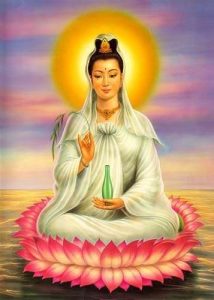 Kwan Yin, Quan Yin, or Guan Yin
Kwan Yin, Quan Yin, or Guan Yin
Quan Yin is one of the most widely loved deities in Buddhism and is now well known all over the world as the goddess of compassion and mercy. You can find images of Quan Yin holding the pearls of illumination or a bundle of ripe rice, pouring the nectar of wisdom and compassion from a sacred vase or meditating and holding her hands in sacred mudras. You can also find Quan Yin holding children or giving food—all being expressions of her divine loving energy. Due to her commitment to helping humans, she is approached with any concerns, troubles, or worries. Be it family, career, health or relationships, no trouble is too big to be brought to the motherly and all-powerful energy. A great protector and benefactor, her heart is full of deep compassion and unconditional love; her energy is God-like. But the terms “compassion and mercy” are actually not the best interpretation of Quan Yin’s energy. The energy Quan Yin expresses is similar to what a mother feels for her child—it is fiercely loving and protective, which is a much stronger energy than what we usually associate with compassion. As the legend goes, even though Quan Yin attained enlightenment, just as she was about to enter the heaven’s gate she paused at the doorway and, hearing the cries of the world, decided to return and help humankind find the right path. She took the vow to help humans, thus Quan Yin is known as a female Bodhisattva. As a Bodhisattva, freed from attachments, she has no need of offerings, worship, praise, demotions. She asks only one thing — that we share her value of Compassion and Metta (love) for all sentient beings.
She is better known simply as Amma (“Mother”), or “the hugger.” She was born in India in 1953 and is a Hindu spiritual leader, guru and humanitarian who is revered as a saint by her followers. As part of her chores in a large family, Amritānandamayī gathered food scraps from neighbors for her family’s cows and goats, and she became deeply aware of the intense poverty and suffering of others. She would bring these people food and clothing from her own home. Her family, which was not wealthy, scolded and punished her. Amṛitānandamayī also began to spontaneously embrace people to comfort them in their sorrow. She has said, “I don’t see if it is a man or a woman. I don’t see anyone different from my own self. A continuous stream of love flows from me to all of creation.” Hugging is her way of existing in the world with her followers, and she has has embraced more than 33 million people throughout the world for over 30 years, sometimes for 20 continuous hours. She says, “If you can touch people, you can touch the world.”
The white buffalo is an American bison and is considered a very rare and sacred animal to Native American. To the Native Americans the birth of a white buffalo is a symbol of rebirth and world harmony. White Buffalo Calf Woman is a supernatural woman who taught the Lakota people, a Native American tribe in the western US, their “Seven Sacred Rituals,” including using the Sacred Pipe, sweat lodges and the vision quest, to communicate with holy ones and to receive sacred messages from the ancestors. She taught about the Sacred Hoop (sacred circle), by saying “When one sits in the Hoop (circle) of the People, one must be responsible, because all of Creation is related, and the hurt of one is the hurt of all, and the honor of one is the honor of all.”
Cybele is the Mother Goddess of Asia Minor, currently the Asian portion of Turkey from about the 5th century BC onward. In Greek the name Cybele predominates, but her Roman name was Magna Mater, Great Mother of the Gods. Mother goddess figures are found in almost every ancient religion, but these figures, which were usually only goddesses of fertility and reproduction in general, should not be confused with the Great Mother of the Gods, who was regarded as the giver of life to gods, human beings, and beasts alike. She was revered for universal motherhood. She was also called the Mountain Mother, mother of the land in its pure natural state and at times took the form of an unshaped black meteoric stone. Her image held aloft signifies the Earth, which “hangs in the air.” She was a mediator between the “boundaries of the known and unknown”: between the civilized and the wild, and between the worlds of the living and the dead.
Mother Teresa
Of Albanian descent, Mother Teresa, whose given name was Agnes, was born in Macedonia in 1910. Her family was of Albanian descent. After her father died when she was about 8 years old, Agnes became extraordinarily close to her mother, who was a pious and compassionate woman who instilled in her daughter a deep commitment to charity. Although by no means wealthy, her mother extended an open invitation to the city’s destitute to dine with her family. “My child, never eat a single mouthful unless you are sharing it with others,” she told her daughter. When Agnes asked who the people eating with them were, her mother answered every time, “Some of them are our relations, but all of them are our people.”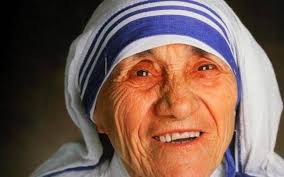
Mother Teresa’s “call” was caring for the sick and poor, and in 1952 she became the founder of the Order of the Missionaries of Charity, a Roman Catholic congregation of women dedicated to helping the poor. Two years later, she established a hospice where the terminally ill could die with dignity. 45 years later, Mother Teresa’s Missionaries of Charity had over 4,000 sisters and hundreds of thousand of volunteers working in hundreds of centers around the world. These included homes for orphaned children, homes for people with HIV/AIDS, leper colonies, and hospices for the terminally ill. Considered one of the 20th Century’s greatest humanitarians, she was awarded the Nobel Peace Prize in 1979. In her Nobel Lecture, Mother Teresa said: “I think that we in our family don’t need bombs and guns, to destroy to bring peace – just get together, love one another, bring that peace, that joy, that strength of presence of each other in the home. And we will be able to overcome all the evil that is in the world.” Three years ago, Pope Francis canonized her as Saint Teresa of Calcutta. Here are some quotes from her you may recognize:
“If you judge people, you have no time to love them.”
“Not all of us can do great things. But we can do small things with great love.”
“I am not sure exactly what heaven will be like, but I know that when we die and it comes time for God to judge us, we will not be asked, ‘How many good things have you done in your life?’ Rather we will be asked, ‘How much love did you put into what you did?’ ”
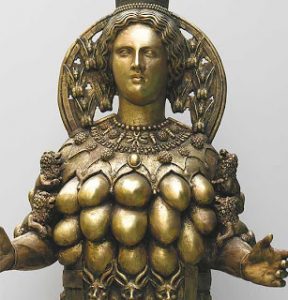 Venus (or Artemis) of Ephesus
Venus (or Artemis) of Ephesus
According to legend, the city of Ephesus in what is now Turkey was first founded by an ancient tribe of great female warriors. The name of the city is thought to mean the “city of the Mother Goddess,” The Mother Goddess lived in Nature; she was wherever there was life, the mother of all living things. Her earliest statues were made of clay or crudely carved in woo and look much like an obese old woman, losing her hair, with her knees buried under layers of fat, her arms heavy, her breasts droopy and full, her hips wide, as if she had given birth to and fed many, many children. In later versions of stone or metal, the upper part of her body was completely covered with rows and rows of breasts, thought to signify that she was the mother of all life.
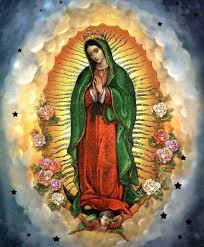 Virgin of Guadalupe (our Lady of Guadalupe, Nuestra Señora de Guadalupe)
Virgin of Guadalupe (our Lady of Guadalupe, Nuestra Señora de Guadalupe)
In 1531, near Mexico City, the Blessed Virgin Mary appeared four times to an Aztec peasant who had converted to Catholicism after the Spanish conquerors. During the fourth appearance, she asked him, “Am I not here, I who am your mother?” This event proved to be a healing point for the indigenous Mexican people who had suffered greatly at the hands of the conquistadores ten years earlier. She is the patroness saint of Mexico. The shrine of the Virgin of Guadalupe in Mexico City is the most visited Catholic pilgrimage destination in the world, and there are many churches throughout the world named in her honor. The Mexican novelist Carlos Fuentes once said that “you cannot truly be considered a Mexican unless you believe in the Virgin of Guadalupe.”
She is the Hindu goddess of prosperity. She is endowed with many divine qualities, and she provides the divine for her consort Vishnu the Preserver, the god who maintains human life filled with justice and peace. Along with Parvati and Saraswati, Lakshmi forms Tridevi, or the holy trinity. The marriage and relationship between Lakshmi and Vishnu as wife and husband is the model for rituals and ceremonies for the bride and groom in Hindu weddings. Lakshmi typically stands or sits like a yogini on a lotus pedestal and holds a lotus in her hand, a symbol for fortune, self-knowledge and spiritual liberation. The lotus can blossom in clean or dirty water, and that symbolizes purity regardless of the good or bad circumstances in one’s life, as a reminder that good and prosperity can bloom and not be affected by evil in one’s surroundings. In the ancient scriptures of India, all women are declared to be embodiments of Lakshmi
Pachamama is a goddess revered by the indigenous people of the Andes Mountains in South America. Pachamama means Madra Tierra, Mother Earth, Mother Nature, or World Mother. She has the creative power to sustain life on this earth. She embodies the mountains. Her shrines are sacred rocks, or the trunks of great trees, and her artists envision her as an adult woman bearing harvests of potatoes and coca leaves. After the conquest of South America by Spain, which forced conversion to Roman Catholicism, the figure of the Virgin Mary became united with that of the Pachamama for many of the indigenous people.
Shakti is really a divine universal cosmic energy that represents feminine energy and the power of creation and is sometimes referred to as “The Great Divine Mother” in Hinduism. Shakti is a Mahadevi, or Great Goddess— a sum of all other goddesses. She is an archetype with 3 major aspects having different names: Parvati, Durga, and Kali.
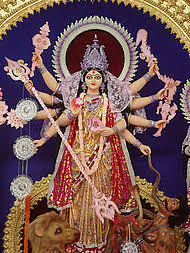 The first aspect, Parvati , is the aspect we probably think of first when we think of the divine feminine.
The first aspect, Parvati , is the aspect we probably think of first when we think of the divine feminine.
is the Hindu goddess of fertility, love, beauty, marriage, children, and devotion as well as of divine strength and power. Known by many other names, she is the gentle and nurturing Mother goddess in Hinduism, and has many attributes and aspects. Each of her aspects is expressed with a different name, giving her over 100 names.
 As Durga, Shakti is a fierce warrior fighting against evil. Stories tell of her killing the terrible buffalo demon that was trying to destroy the world, because lesser gods were not able to do so. Durga is the protective mother of the universe, who protects all that is good and harmonious in the world. As mother protector, Durga has many arms so that she may always be ready to battle evil from any direction. She is willing to unleash her anger against wrong and all that threatens freedom and creation. Her icon shows her in action, but her face is calm and serene. In Hindu arts, this tranquil attribute of Durga’s face is traditionally derived from the belief that she is protective and violent not because of hatred, egotism or getting pleasure from violence, but because she acts out of necessity, for the love of the good and for liberation of those who depend on her. Our Durga aspect helps us fight our own personal demons.
As Durga, Shakti is a fierce warrior fighting against evil. Stories tell of her killing the terrible buffalo demon that was trying to destroy the world, because lesser gods were not able to do so. Durga is the protective mother of the universe, who protects all that is good and harmonious in the world. As mother protector, Durga has many arms so that she may always be ready to battle evil from any direction. She is willing to unleash her anger against wrong and all that threatens freedom and creation. Her icon shows her in action, but her face is calm and serene. In Hindu arts, this tranquil attribute of Durga’s face is traditionally derived from the belief that she is protective and violent not because of hatred, egotism or getting pleasure from violence, but because she acts out of necessity, for the love of the good and for liberation of those who depend on her. Our Durga aspect helps us fight our own personal demons.
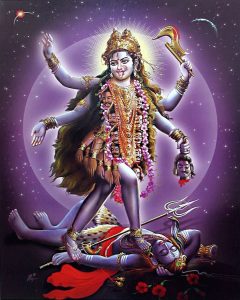 Kali is another form of Shakti who is worshiped throughout India. As one story goes, she sprang from Durga’s forehead when two demons tried to attack Durga. From this interpretation, she was born from Durga’s anger, with the purpose of destroying evil and restoring balance. Her name is commonly translated as “the black one,” but the name actually means “force of time.” When there was not yet any creation, no sun, moon, planets, or earth, there was only darkness and everything through the force of time was created from the darkness. Kāli is said to refrain from giving that which is expected. To the devotee, it is perhaps her very refusal to do so that enables her devotees to reflect on dimensions of themselves and of reality that go beyond the material world. Despite Kali’s origins in battle and anger, she evolved to a full-fledged symbol of Mother Nature in Her creative, nurturing and devouring aspects. In this aspect, as Mother Goddess, she is referred to as Kali Ma, meaning Kali Mother. Some traditions say that the gods Brahma, Vishnu, and Shiva all arise from her like bubbles in the sea, ceaselessly arising and passing away, leaving their original source unchanged.
Kali is another form of Shakti who is worshiped throughout India. As one story goes, she sprang from Durga’s forehead when two demons tried to attack Durga. From this interpretation, she was born from Durga’s anger, with the purpose of destroying evil and restoring balance. Her name is commonly translated as “the black one,” but the name actually means “force of time.” When there was not yet any creation, no sun, moon, planets, or earth, there was only darkness and everything through the force of time was created from the darkness. Kāli is said to refrain from giving that which is expected. To the devotee, it is perhaps her very refusal to do so that enables her devotees to reflect on dimensions of themselves and of reality that go beyond the material world. Despite Kali’s origins in battle and anger, she evolved to a full-fledged symbol of Mother Nature in Her creative, nurturing and devouring aspects. In this aspect, as Mother Goddess, she is referred to as Kali Ma, meaning Kali Mother. Some traditions say that the gods Brahma, Vishnu, and Shiva all arise from her like bubbles in the sea, ceaselessly arising and passing away, leaving their original source unchanged.
These are statues or paintings of the Blessed Virgin Mary in which she, and often the infant Jesus, are depicted with black or dark skin. The Black Madonnas can be generally found in Catholic and Orthodox countries, mostly wooden but occasionally in stone, and often painted. The pictures are usually icons which are Byzantine in style, often made in 13th- or 14th-century Italy. There are about 400–500 Black Madonnas in Europe, almost 200 of them in France. They are also found in Japan, the Philippines, South America and the Caribbean. Some are in museums, but most are in churches or shrines . The speculations behind the reason for the dark skin of each individual piece vary greatly, Though some Madonnas were originally black or brown when they were made, others have simply turned darker due to factors like aging or candle smoke. Another cause for the dark-skinned depiction is due to pre-Christian deities being re-envisioned as the Madonna and child, with the idea that these depictions are more accurate to historical Mary, since many of the works are eastern in origin and since Mary herself likely had dark skin.
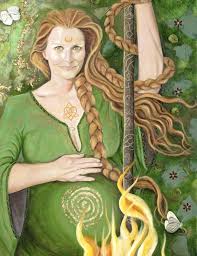 Brigit, Brigid, Brig, or Bridget
Brigit, Brigid, Brig, or Bridget
These names refer to a goddess (or goddesses) of pre-Christian Ireland. The basic name means “exalted one”. She is associated with the spring season, fertility, healing, and poetry. A glossary by Christian monks 1000 years ago says that Brigid was “the goddess whom poets adored” and that she had two sisters: Brigid the healer and Brigid the smith, This suggests she may have been a triple deity. In the Middle Ages the goddess Brigid was united with the Christian saint of the same name. St. Brigid is associated with keeping perpetual, sacred flames, The tradition of female priestesses tending sacred, naturally occurring eternal flames is a common feature of pre-Christian spirituality. Both the goddess and saint are also associated with holy wells and healing coming from them.
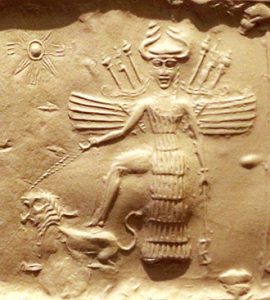 Inanna (also Ishtar and Astarte)
Inanna (also Ishtar and Astarte)
Inanna is the most important goddess from the ancient Mesopotamian region (now Iraq and parts of Turkey and Syria). She is primarily known as the goddess of sexual love, especially outside of marriage, and of warfare. In her astral aspect, she is the planet Venus, the morning and the evening star. Inanna is NOT a goddess of marriage, nor is she a mother goddess!
Instead, she has a vastly different personality. Inanna is an independent woman who does as she pleases, quite often without regard for consequences, and she manipulates, threatens, or tries to seduce others to fix the difficulties her behavior creates. Inanna is impulsive and frequently careless with others’ feelings or property or even their lives. She was portrayed as constantly striving for more power than she had been given initially. The fact that the Sumerians could conceive of such a goddess speaks to their culture at the time, how they understood femininity and a belief that women were regarded as equals.
Sri Anandamayi Ma (1896-1982) was one of the greatest Hindu saints of the 20th century. She was born in present-day Bangladesh in 1896 and lived for 86 years. Her Sanskrit name translates as “joy-permeated.” Anandamayi Ma was one of the most influential spiritual teachers of our time. Her devotees ranged from prime ministers to renowned saints to humble villagers. Although she had very little formal education, Ma spoke with the authority of direct experience. Wherever she went, miracles followed. From suddenly appearing at the bedside of a dying woman… to breathing life into an ant crushed thoughtlessly underfoot…everything was manifested effortlessly and graciously through Ma, and she lived in a state of constant bliss and joy. She was a contemporary of many well known Hindu saints such as Sri Aurobindo, Ramana Maharshi, and Paramahansa Yogananda and was highly regarded by them. One of them described her as “the most perfect flower the Indian soil has produced”.
Late in her life, she said, ”When I served my father, mother, husband, and others, I simply considered them as different manifestations of the Almighty, and served them as such. When I sat down and prepared food, I did so as if it were in a ritual, for the food cooked was, after all, meant for God. Whatever I did, I did in the spirit of the divine service. Hence, I was not quite worldly, though always engaged in household affairs. I had but one ideal, to serve all as God, to do everything for the sake of God.” She welcomed and conversed with devotees of all different paths and religions. Everyone was welcome. Many Muslims still refer to her as “our own Ma”. A quote from her is, “Whether you worship Christ, Krishna, Kali or Allah, you actually worship the one Light that is also in you, since It pervades all things.”
“God has made us in her Image. We are each like a tiny, scaled-down reflection of a certain aspect of God’s Infinity.”

